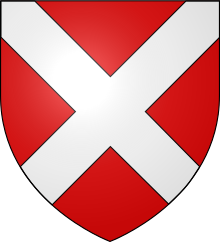
Henry IV, also known as Henry Bolingbroke, was King of England from 1399 to 1413. Henry was the son of John of Gaunt, Duke of Lancaster, and Blanche of Lancaster.

Thomas de Mowbray, 1st Duke of Norfolk, KG was an English peer. His family was a venerable one, and by the time Thomas reached adulthood, they were extremely influential in national politics. He claimed a direct bloodline from King Edward I. His father died when Thomas and his elder brother were young. John soon died, and Thomas inherited the Earldom of Nottingham. He had probably been friends with the king, Richard II, since he was young, and as a result, he was a royal favourite, a role he greatly profited from. He accompanied Richard on his travels around the kingdom and was elected to the Order of the Garter. Richard's lavish dispersal of his patronage made him unpopular with parliament and other members of the English nobility, and Mowbray fell out badly with the king's uncle, John of Gaunt.

Richard of Conisbrough, 3rd Earl of Cambridge was the second son of Edmund of Langley, 1st Duke of York, and Isabella of Castile, Duchess of York. He was beheaded for his part in the Southampton Plot, a conspiracy against King Henry V. He was the father of Richard Plantagenet, 3rd Duke of York, and the grandfather of King Edward IV and King Richard III.
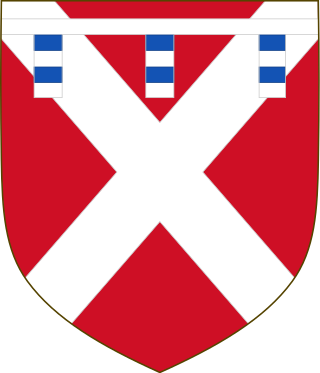
Richard Neville, 5th Earl of Salisbury KG PC was an English nobleman and magnate based in northern England who became a key supporter of the House of York during the early years of the Wars of the Roses. He was the father of Richard Neville, 16th Earl of Warwick, the "Kingmaker".

William Hastings, 1st Baron Hastings KG was an English nobleman. A loyal follower of the House of York during the Wars of the Roses, he became a close friend and one of the most important courtiers of King Edward IV, whom he served as Lord Chamberlain. At the time of Edward's death he was one of the most powerful and richest men in England. He was executed following accusations of treason by Edward's brother and ultimate successor, Richard III. The date of his death is disputed; early histories give 13 June, which is the traditional date.

Ralph Neville, 1st Earl of WestmorlandEarl Marshal, was an English nobleman of the House of Neville.
Baron Furnivall is an ancient title in the Peerage of England. It was originally created when Thomas de Furnivall was summoned to the Model Parliament on 24 June 1295 as Lord Furnivall. The barony eventually passed to Thomas Nevill, who had married the first baron's descendant Joan de Furnivall, and he was summoned to parliament in her right. Their daughter, Maud de Neville, married John Talbot, who was also summoned to parliament in her right. He was later created Earl of Shrewsbury. On the death of the seventh earl in 1616, the barony fell into abeyance. The abeyance was terminated naturally in favour of the earl's daughter Alethea Howard in 1651 and passed through her to the Dukes of Norfolk. On the death of the ninth Duke in 1777, the barony again fell into abeyance. In 1913 the abeyance was terminated again in favour of Mary Frances Katherine Petre, daughter of Bernard Petre, 14th Baron Petre. Through her father she was a great-great-great-granddaughter of the ninth Baron Petre and his first wife Anne Howard, niece of the ninth Duke of Norfolk, who became co-heir to the Barony on her uncle's death in 1777. On Lady Furnivall's death in 1968 the barony fell into abeyance for the third time.

William de Ros, 6th Baron Ros, was a medieval English nobleman, politician and soldier. The second son of Thomas de Ros, 4th Baron Ros, and Beatrice Stafford, William inherited his father's feudal barony and estates in 1394. Shortly afterwards, he married Margaret, daughter of John FitzAlan, 1st Baron Arundel. The Fitzalan family, like that of de Ros, was well-connected at the local and national level. They were implacably opposed to King Richard II, and this may have soured Richard's opinion of the young de Ros.
John Fitzalan, 1st Baron Arundel, also known as Sir John Arundel, was an English soldier.

Thomas Hoccleve or Occleve (1368/69–1426) was a key figure in 15th-century Middle English literature, significant for promoting Chaucer as "the father of English literature", and as a poet in his own right. His poetry, especially his longest work, the didactic work Regement of Princes, was extremely popular in the fifteenth century, but went largely ignored until the late twentieth century, when it was re-examined by scholars, particularly John Burrow. Today he is most well known for his Series, which includes the earliest autobiographical description of mental illness in English, and for his extensive scribal activity. Three holographs of his poetry have survived, and he also copied literary manuscripts by other writers. As a clerk of the Office of the Privy Seal, he wrote hundreds of documents in French and Latin.

Lady Elizabeth de Montfort, Baroness Montagu was an English noblewoman.
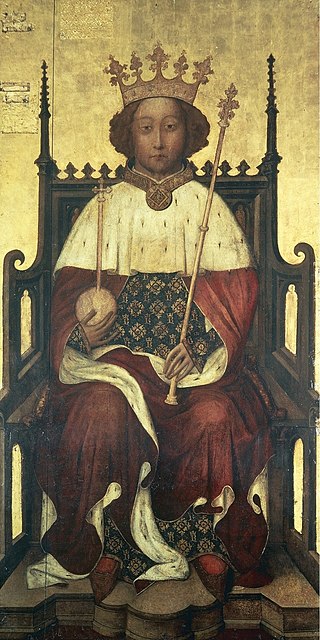
The Wonderful Parliament was a session of the English parliament held from October to November 1386 in Westminster Abbey. Originally called to address King Richard II's need for money, it quickly refocused on pressing for the reform of his administration. The King had become increasingly unpopular because of excessive patronage towards his political favourites combined with the unsuccessful prosecution of war in France. Further, there was a popular fear that England was soon to be invaded, as a French fleet had been gathering in Flanders for much of the year. Discontent with Richard peaked when he requested an unprecedented sum to raise an army with which to invade France. Instead of granting the King's request, the houses of the Lords and the Commons effectively united against him and his unpopular chancellor, Michael de la Pole, 1st Earl of Suffolk. Seeing de la Pole as both a favourite who had unfairly benefited from the King's largesse, and the minister responsible for the King's failures, parliament demanded the earl's impeachment.

John Neville, 3rd Baron Neville, was an English peer, naval commander, and soldier. His second wife was Elizabeth Latimer who was the 5th Baroness Latimer in her own right.
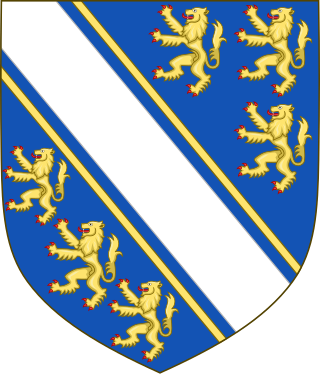
Eleanor de Bohun was the elder daughter and co-heiress, of Humphrey de Bohun, 7th Earl of Hereford (1341–1373) and Joan Fitzalan, a daughter of Richard FitzAlan, 10th Earl of Arundel and his second wife Eleanor of Lancaster.

William Ufford, 2nd Earl of Suffolk was an English nobleman in the reigns of Edward III and Richard II. He was the son of Robert Ufford, who was created Earl of Suffolk by Edward III in 1337. William had three older brothers who all predeceased him, and in 1369 he succeeded his father.

William Montagu, 2nd Baron Montagu, was an English peer, and an eminent soldier and courtier during the reigns of Edward I and Edward II. He played a significant role in the wars in Scotland and Wales, and was appointed steward of the household to Edward II. Perhaps as a result of the influence of his enemy, Thomas, 2nd Earl of Lancaster, Edward II sent him to Gascony as Seneschal in 1318. He died there in October of the following year.

Thomas Courtenay, 6th/14th Earl of Devon, was the eldest son of Thomas de Courtenay, 5th/13th Earl of Devon, by his wife Margaret Beaufort, the daughter of John Beaufort, 1st Earl of Somerset, and Margaret Holland, daughter of Thomas Holland, 2nd Earl of Kent. Through his mother, he was a great-great-grandson of King Edward III. The ordinal number given to the early Courtenay Earls of Devon depends on whether the earldom is deemed a new creation by the letters patent granted 22 February 1334/5 or whether it is deemed a restitution of the old dignity of the de Redvers family. Authorities differ in their opinions, and thus alternative ordinal numbers exist, given here.
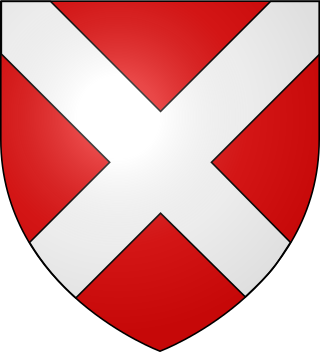
The Neville–Neville feud was an inheritance dispute in the north of England during the early fifteenth century between two branches of the noble Neville family. The inheritance in question was that of Ralph Neville, 1st Earl of Westmorland, a prominent northern nobleman who had issue from two marriages. Westmorland favoured as his heirs the children of his second wife, Joan Beaufort, closely related to the royal family, over those of his first wife, Margaret Stafford.

Sir John Neville was the eldest son of Ralph Neville, 1st Earl of Westmorland, a powerful nobleman in northern England, and Margaret Stafford, his first wife. As heir apparent to the earldom of Westmorland, he was styled 'Lord Neville'.
Margaret de Neville, also Margaret de Longvillers and domina Margareta de Nevill was an English landowner in Yorkshire and Lancashire during the thirteenth and fourteenth centuries. Her inheritance helped to consolidate the power and influence of the House of Neville.
